Double white dwarfs
Common-envelope
evolution
AM CVn stars
Ultra-compact X-ray
binaries
Black hole binaries
SN Ia progenitors
Surveys
Gravitational waves
LISA wiki (verification
binaries)
Publications
Preprints
My thesis
Gravitational waves
The first gravitational wave source, GW150914 was discovered in 2015 and published in 2016. It is the merger of two heavy black holes (30 and 35 solar mass) into a single black hole of 62 solar masses. The source mergerd at about 400 Mpc and could have formed either from the evolution of an isolated binary of by dynamical interaction in a dense stellar environment (see the astrophysical interpretation paper.
Gravitational waves from double white dwarfs
The ESA/NASA gravitational wave mission LISA (ESA site) will be sensitive to low-frequency gravitational waves. In this frequency range there are a large number of Galactic binaries with white dwarf and/or neutron star components. Especially the double white dwarfs are expected to form an unresolved background. We used our model of the Galactic population of double white dwarfs, together with our results for compact binaries with neutron star and black holes to simulate the galactic binary signal as it would be observed with LISA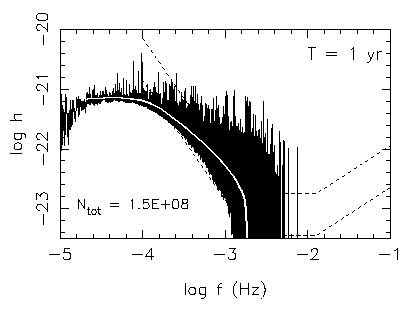
Gravitational wave signal as observed with LISA for a total integration time of 1 year. It is assumed that LISA has no angular resolution. The thick white line gives the average unresolved white dwarf background (from Nelemans et al 2001, A&A, 375, 890).
Gravitational waves from AM CVn systems
Although AM CVn systems hardly contribute to the gravitational wave background it turns out that in the frequency range where the double white dwarf systems are resolved, there are also a large number of AM CVn systems that can be resolved by LISA (for more information see my contribution for the 4th LISA symposium and Nelemans et al. 2004.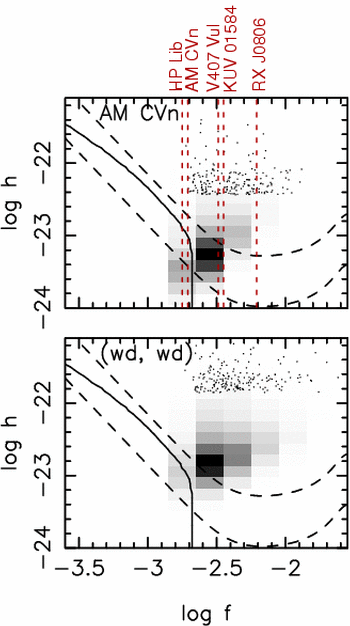
Short period double white dwarf and AM CVn systems that will be resolved by the gravitational wave detector in space LISA.The grey shades gives the normalized distribution (N_max = 1823 for (wd,wd) and 1548 for AM CVn) of resolved systems, the dashed lines the proposed LISA sensitivity and the solid line the unresolved double white dwarf noise background. The orbital periods of (proposed) short period AM CVn systems are indicated in red (from Nelemans et al. 2004b)
Gravitational waves from known binaries
A number of known binaries will be (strong) LISA sources. In particular the candidate AM CVn systems RX J0806.3=1527 and V407 Vul would be strong sources, but definite AM CVn and UCXB systems such as ES Cet, HP Lib, AM CVn and 4U 1820-30 will also be easily detectable. You can make plots like this at the following page (username GWR, passwd lisa).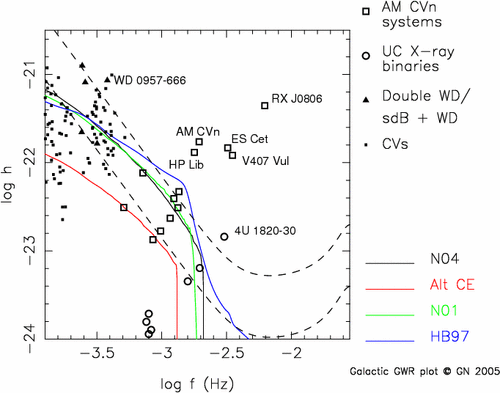
LISA signals of known sources. The solid lines show the different estimated double white dwarf backgrounds.
LISA Science Case
In the fall of 2006 we have been writing the LISA Science case. In the document the different areas of (astro)physics in which LISA will contribute to solving fundamental questions are described.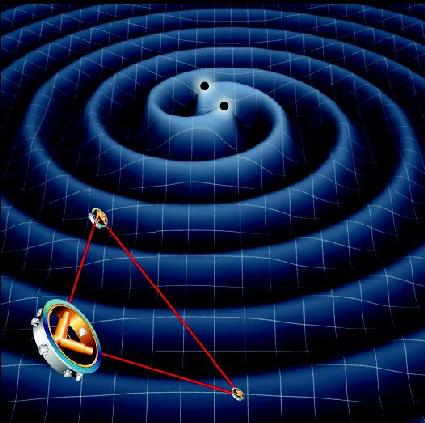
Black holes
By measuring the merging of supermassive black holes in the coalescence of galaxies over cosmic history, the process of structure formation in the universe can be studied.Testing relativity
By measuring the exact way in which supermassive black holes emit gravitational waves Einstein's theory of General relativity can be tested. Important aspects will be tested by compact objects (stellar mass black holes and neutron stars) falling into supermassive black holes (so called extreme mass-ratio inspirals).Cosmology
The gravitational radiation of supermassive black holes will be detected to such large distances (and hence to such early times in the evolution of the Universe) that the expansion of the Universe can be mapped in great detail. This will yield important constraints on the recently discovered dark energy which comprises about 73 per cent of the energy in the Universe.Compact binaries
LISA will revolutionarize our knowledge about compact binaries in our Galaxy. The expected number of detections are counted in thousands, if not ten-thousands. This will not only offer the possibility to study the physical processes that drive the evolution of these binaries in detail, but will also yield enough statistics to use these binaries as probes of Galactic structure.New physics
The cracks that are showing in the current standard model of fundamental physics show that our knowledge on the smallest scales and highest energies is incomplete at best. A new way of probing these scales may be the detection of gravitational waves from the very early beginning of the Universe.>> Download the complete document (11MB, pdf)
See also
eLISA/NGO a new ESA only mission
After NASA withdrew from the LISA project early 2011, ESA formed a repid redefinition team to investigate the feasibility of a smaller, but affordable and technically ready ESA only mission to detect low-frequency gravitational waves. The new mission eLISA turned out to be feasible and still produce great science. ALthough it was not selected for ESA's L1 mission, it is a great candidate for the L2 launch in 2028.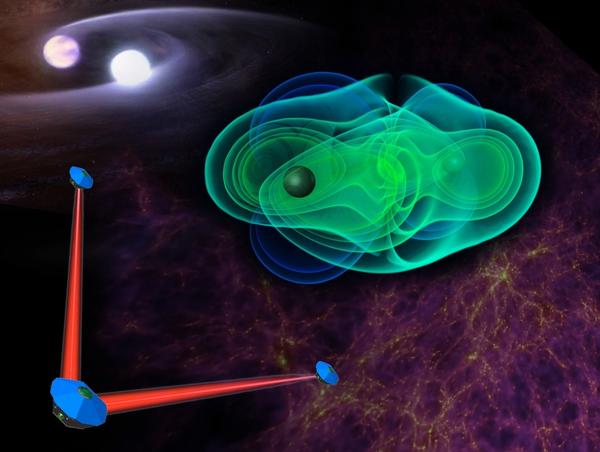
See the eLISA website for all the details.
See the eLISA website for all the details.
